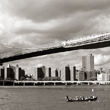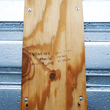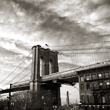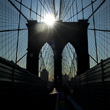Brooklyn Bridge (1867-1883)
Designated as National Historic Landmark in 1964
Between Cadman Plaza, Brooklyn and
City Hall Park, Manhattan
The Brooklyn Bridge is one of the most iconic structures in New York City and also easily one of the most photographed. In recent years, walking across it to visit the Brooklyn neighborhood of DUMBO (also landmarked) has become an increasingly popular tourist activity. While I love walking across it myself, as a New Yorker I do it mostly for convenience sake since it's practically right outside my front door and the easiest way for me to get to Lower Manhattan. In the summer, this requires trying to avoid the huge crowds. For bikers, this requires trying not to hit the tourists who don't realize they've wandered into the bike lane.
In addition to being aesthetically marvelous, the Brooklyn Bridge is also considered a great engineering achievement. The German engineer, John A. Roebling, designed what at the time was the longest suspension bridge in the world and was the first to use steel-wire cables. However, an accident led to his death while the bridge was still in the early stages of construction. The project was left to his son, Washington Roebling, to complete. Washington too suffered an injury, getting caisson disease (otherwise known as decompression sickness) from descending into the deep caissons for the bridge sunk into the East River. Washington Roebling then had to rely on his wife, Emily, to be his eyes, ears, and mouth, while he continued supervising construction from the window of a house in Brooklyn Heights. When the bridge was completed, it was the first physical link between the then independent cities of Brooklyn and New York. Another true story: P.T. Barnum walked his elephants across the bridge to prove it could support heavy weights.
Click any of the thumbnails below to go to the image gallery.
















